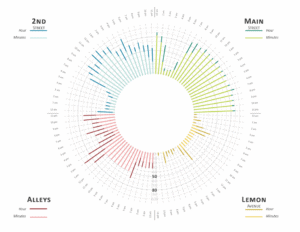By Chrissy Mancini Nichols and Jonathan Wicks, CAPP
This blog is a summary of the Frontline Fundamental session titled: Curb Management – Lessons Learned. The full session is available in the IPMI On-Demand Education Library, free to members and $35 for non-members – click here to order.

The Curb is One of the Most Valuable Assets
In our rapidly changing world, the humble curb is seeing a convergence of competing uses. From an increase in pick-ups and drop-offs to new ways to get around like shared bikes and scooters, curb space must be managed to ensure accessibility, safety, and circulation.
Benefits of Curb Management
The curb is more than just vehicle storage or a path of travel: it is there to serve people. It’s a vital community space and one of the most extensive and valuable assets in a city. A good curb design promotes access and activity, drawing more customers for businesses. Cities must understand their curb utilization to determine the best mix of curb uses based on actual activity data, mobility, and land use goals.
Walker’s Curb Management Research Project

To know parking is to know the curb. Curb management is an integral part of Walker’s planning, design, and financial studies and we know cities have different needs and require context-specific solutions. However, there are a variety of unknowns related to data, technology, regulations, and implementation of curb management. There is also a spectrum of tools available to plan and implement curb management, and many are still in the testing phase.
Walker’s recent presentation on our curb management research project, which devotes pro bono staff time to find answers to these unknowns, is now available to watch on demand. We are helping cities of various needs strategize on how to solve a specific curb management issue, with a goal of creating a curb management model that can be localized. The research project is exploring:
Data Collection and Analysis
- Collect curb inventory and activity data and analysis
Planning and Testing
- Pilot and test new curb designs and regulations
- Develop curb use typologies and models
- Vet, test, and leverage emerging curb management technology
Policy and Partnerships
- Establish curb use goals and priorities with the community and stakeholders
- Review existing curb policies and identify issues/draft policies
- Evaluate curb pricing for all users
- Identify partnerships and agreements necessary for implementation, including public-private partnerships
Chrissy Mancini Nichols is national director of curb management and new mobility with Walker Consultants.
Jonathan Wicks, CAPP is a consultant with Walker Consultants.
